


Forests in Turkey are made up of a variety of species based upon differences in local ecological conditions. Recently, non-wood forest products have started taking on increasing importance alongside raw wood materials, which remains the forests’ chief product. Although revenues from the former seem to supplement those from timber products, in fact the money earned from some species actually exceeds timber returns.
Turkey’s most important non-wood forest products are pine nuts, storax, chestnuts, pine and oak bark, tar, gallnuts, common heather and the cores of various leaves and flowers. The evaluation and collection of the species from which these products come is not harmful to the forest ecosystems; their own natural flowering also produces their fruits.
Among these species, Pinus pinea, the Stone Pine, has especially shown important developments, especially since the beginning of the 1970s. There is large demand for its pine nuts as a delicious food product.
This beautiful species, known in English as the “Umbrella Pine” due to its umbrella-like growing pattern, looks much like a flower bunch. It is found as far afield as coastal regions of Portugal, but its widest geographical distribution is found in Anatolia. The naturally forested region of Kozak in western Anatolia is one where Stone Pines especially grow and flourish. The region’s precipitation pattern and sunny highlands have boosted the quality of the local nuts and put them at a premium.
The Kozak region, which encompasses 16 villages, is located in the western Turkish province of İzmir on the outskirts of the town of Bergama. Kozak’s people are literate, and it is a model region in terms of its education, population planning (birth control), and transportation infrastructure. The locals’ main sources of livelihood are agriculture and forestry. Harvesting is done via the labor of people, not machines, since almost 50% of the land is steep and stony and its productive areas very scattered. Limited water resources in the region serve to limit its agricultural production. Care must be taken to properly evaluate the lands in Kozak which face harsh geographical conditions. The expansion of Pinus pinea’s pine nuts as a non-wood, high-value forest product through the use of non-traditional agricultural techniques has aided the region’s development. The species’ distribution has swelled owing to its economic returns, easily marketability, low input costs, and the fact that it can be harvested using only a small workforce during roughly half of the year.
The Stone Pine flourishes at altitudes of up to 700 m in areas where the Mediterranean climate prevails and the principal rock is granite. The tree’s pine nuts have great economic importance for Kozak since the region’s sandy, stony, rocky soil is unreceptive to other forms of agriculture. In fact, Kozak is virtually synonymous with Stone Pines. Beyond its contributions to the beauty of the region, the Stone Pine is an source of livelihood for its people. Moreover, were something to significantly damage the output of Stone Pine nuts, this would almost certainly spell the end of Kozak, since animal husbandry no longer has the value for the region that it once had.
Rising revenues from pine nuts have also led Kozak’s locals to make investments into animal husbandry, agriculture and horticulture. The locals are open to reforms and eager to emulate advances in other rural areas. However, entrepreneurship in the region remains quite rare and generally does not go beyond individual efforts. In late 2002/early 2003, a federation was established by a local town leader and with the participation of area villages in order to support such entrepreneurship and to accelerate Kozak’s socioeconomic development.
Kozak’s private forests are situated very near to its state forests, and these forests are very well protected, exhibiting a fine model of state-villager cooperation for forest improvement. Looking in depth at the history and present state of Kozak, as an almost-model region, could lead other forest villages to pursue similarly wise practices and contribute to their own success.
Recently the issue of participation in the areas of forest management, forest resource usage and social forestry has taken on new urgency. There is more and more discussion of promoting local participation in and support for sustainable forest management. The Turkish government has taken part in this trend through emphasizing participation in the preparation of the National Forestry Program in order to ensure effective planning and workable policies. The government has also taken initial steps to put into effect this participation principle in all forestry activities.
In addition to this participation policy, boosting the incomes of forest villagers through rural development is key to diminishing the pressures on forest resources and sustainable forestry.
The Kozak region and its private forests provide a good model for such sustainable forest management. No other forestry system in Turkey enjoys so much popular support. One could conclude that the system is successful by virtue of the revenues and public benefits that it brings. However, one should also take into account the way the Stone Pine and its nut are bound up with the locals’ way of life as well as historical ownership factors. The people of Kozak have owned the lands and, despite periodic setbacks, continually worked for their development. Following the 1923 foundation of the Republic of Turkey, when its forest boundaries were being drawn and cadastral (ownership) surveys were being conducted, the villagers of Kozak put forth great efforts to obtain official registrations for these Stone Pine lands. At length these endeavors yielded success.
However, efforts for many other species in other Turkish forests – including, in some cases, other Stone Pine areas – did not enjoy similar success. Yet establishing practices like Kozak’s in other forests, both for Stone Pines and many other species, would promote better protection and development of these lands and their products, as well as lighten the state’s burden, even if their returns do not equal those of Kozak’s Stone Pines. In addition, if such products are used wisely, this would raise the standard of living of other forest villages. Better familiarity with and emulation of the Kozak model and its key successful practices could contribute greatly to the establishment of sound natural resource usage systems in other locales. Exploring Kozak and similar examples and extrapolating their lessons into new policies and practices would save valuable time as well as head off any repetitions of errors seen previously in Kozak.
This study of the Kozak Plateau, or highland (yayla), examines tree and soil management, regional conditions, and the effects of its management system on the socioeconomic conditions of the local rural residents, most of whom earn their living from Stone Pines. Also explored in this study are the thoughts of Stone Pine owners about what they need the most, particularly with regard to local problems and proposals for solutions.
It is hoped that the findings of this study will lead to the establishment of other areas following practices similar to Kozak’s, to sustainable management practices for Turkey’s forest resources, and to support for rural development under the National Forestry Program.
Kozak is located 20 km northwest of Bergama, north of the Aegean Sea. It is encircled by Mt. Madra to the east, crowned by Mt. Yaylacık and Mt. Bezirgan, with Mt. Dede to the north, Esirik Creek to the west, and Kozak Creek (Madra) and Mt. Sakar to the south.
The area boasts the most beautiful geography of the Aegean region, and its most fascinating economic resource is Kozak itself. Stone Pine trees cover the whole plateau like giant green flowers and make an impressive landscape viewed from the hilltop before turning to the village of Yukarıbey (Figure 1.1). The altitude of Kozak’s highland varies from 500 to 1,000 meters. The altitude at Mt. Madra’s Maya hill is 1,344 m, compared to 1,220 m at Mt. Yayla’s Yaylacıkdede hill, 968 m at Mt. Koca’s Kurtburun hill, 120 m at the confluence of the Kozak and Esirik Creeks, 730 m at the hills of Hisar, Göbeller and Aşağıbey, 490 m at Yukarıbey, 270 m at Demircidere, 550 m at Ayvatlar, 500 m at Kaplan, and around 490 m at Aşağıbey.
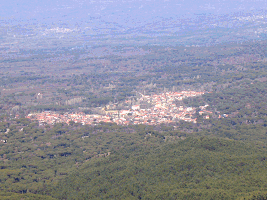
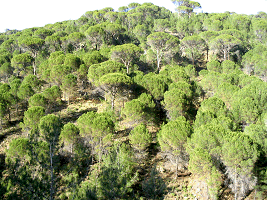
1.1. Overview of the Kozak region and its Stone Pine forests.
The people of Kozak are descended from nomads (yörük). All its villages were populated by Kılaz nomads of the Oğuz clan, excepting Demircidere, which was settled by tahtacı nomads. The nickname of these latter villagers, tahtacı (literally, “wood seller”), comes from their longtime tradition of working as lumberjacks. They are also distinguished from other villagers by their Alawite faith, and their Demircidere is said to have the most colorful social life in the region.
Kozak’s climate is of the continental Mediterranean type, with winters harsher and summers warmer than in the Aegean coastal regions. Kozak sees both the first snow of winter and the first rain of spring. During the summer, the days are hot and the nights warm. A temperature differential between day and night characteristic of continental climates is very common here.
Kozak’s principal rock is granite, and its soil composition is the world’s most favorable for growing the Stone Pine, an extremely hard-wooded plant which favors sandy, gravelly soil.
Kozak’s main vegetation consists of Pinus brutia, Stone Pines, Valonia Oaks and wild pears in zones where its continental Mediterranean climate predominates, and poplar and platanus in its wetlands and riverbanks (Figure 1.2). While 15-20 years ago there was extensive grape cultivation in the villages west of the highland, and extensive horticulture in the eastern villages, both have since been displaced by the Stone Pine.
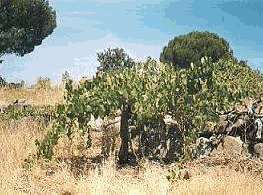
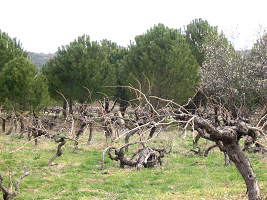
Figure 1.2. A vineyard replaced by Stone Pine plantations.
Kozak has a distinctive community structure characterized by the united village type. In response to rising populations, new houses were constructed in gardens, whereas the gardens themselves contracted, and villages showed little expansion towards the outside.
In terms of shape, the village structures are roughly circular. Mosques, cafés, public toilets and the building for the village leader (muhtar) are located in the center. Village square and roads have been covered with Kozak stones, which are indigenous to the region. Animal barns are located at the foot of houses or in their gardens in some villages, or outside the village proper in others. There is an increasing trend in the region towards moving these barns outside the villages and making healthier, more aesthetically pleasing village structures.
Before acquiring its present economic value, Stone Pine cultivation in Kozak was hindered by many factors. Stone Pine forests were destroyed or damaged in order to obtain timber for a variety of purposes: iron mines, houses, garden fences, heating, charcoal production, and industrial-purpose cuttings. During uncontrolled grazing, animals – mainly goats – caused great damage by eating young seedlings and sprouts. Though in 1937, when extensive Stone Pine cultivation first began in the region, goat breeding was very common, it has since dropped drastically. In interviews, locals said that the practice had largely been abandoned due to the harm done to the pines.
A 1920 land survey recorded 20,000 ha of Stone Pines in the region, but in just over a decade, according to a 1931 survey, these areas were halved to only 10,000 ha. In 1940 the state Forest Cadastral Commissions conducted a study of demands for land tenure rights in forests. Table 1.1 shows the study’s findings concerning Stone Pine forest areas within the boundaries of 9 out of Kozak’s 10 villages with natural Stone Pine forests. At the time of the study, a total of 9,424.4 ha of Stone Pine forests were recorded, of which 7,486.9 ha were pure Stone Pine forests. The village of Yukarıbey was not included in the table, due to inheritance disputes and the lack of cadastral study owing to ownership problems. These cadastral problems have continued to the present day.
Table 1.1 Private Stone Pine Forestland (ha) According to the 1940 Forest Cadastral Commissions Study
Village |
Pure Stone Pine forest |
Mixed forest*(ha) |
Agriculture land and land with pine (ha) | ||
Size (ha) |
No. |
Average size (ha) | |||
Hacıhamzalar |
599.5 |
445 |
1.35 |
270.0 |
380.0 |
Aşağıcuma* |
788.5 |
109 |
7.23 |
- |
319.0 |
Ayvatlar |
304.4 |
49 |
6.21 |
- |
12.0 |
Okçular |
354.5 |
24 |
14.77 |
- |
- |
Demircidere |
289.0 |
154 |
1.88 |
167.5 |
59.0 |
Kaplan |
1,167.0 |
46 |
25.37 |
7.0 |
4.0 |
Aşağıbey |
2,158.0 |
73 |
29.56 |
337.2 |
153.3 |
Hisar |
336.0 |
93 |
3.61 |
- |
34.0 |
Göbeller |
1,490.0 |
45 |
33.11 |
83.0 |
111.5 |
Total |
7,486.9 |
1,038 |
7.21 |
864.7 |
1,072.8 |
Grand total |
9,424.4 | ||||
*Stone Pine+Pinus brutia mixed forests
As seen in Table 1.1, forests in the region ranged in size considerably, with an average size of 7.21 ha. There was a total of 1,038 private forests and of this number, 635 (61.4%) were less than 5 ha, 253 were 5-10 ha, and 144 were 10-50 ha, with only six exceeding 50 ha. Since that study these lands have individually shrunk due to inheritance, and Stone Pine forests especially in Aşağıbey, Hisar and Ayvatlar now consist of very small areas.
As seen from the statistical data presented, the Stone Pine forests were the villagers’ responsibilities until legal arrangements were made in the 1940s. However, even since that time, villagers worked to partially protect Stone Pine areas where they harvested nuts. The areas’ boundaries were marked by fences with a conception of ownership in order to head off any disputes over harvesting (Figure 1.3). The villagers’ strong sense of solidarity and mutual respect served to prevent theft and ensure that harvesting was done when the nuts reached maturity. During the 1940 cadastral studies, the number of private forests and the size of state forests were also determined. Even in these years, only 44.4 ha of state forests were identified in Kozak region forests. Following these studies, there was an acceleration of legal efforts to establish clear ownership and obtain official land registrations.
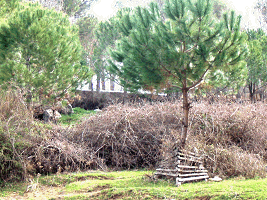
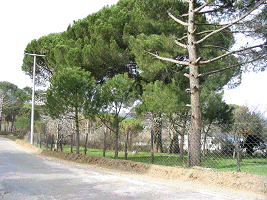
Figure 1.3. Villagers marked the boundaries of Stone Pine lands with fences.
In the literature on forestry, the Stone Pine (Pinus pinea) is a member of the pinus family under the category main forest trees. Forest villagers have been reaping the benefits of Stone Pines for many years, especially in the western parts of Anatolia. Interviews with villagers revealed that the Sultan Land Registrations had first been given to them during the Ottoman Empire period. These land registrations are currently noted as old registrations.
After the establishment of the Republic of Turkey, forestland was first defined in Forest Law No. 3116 (dated 18 Feb. 1937) as follows: “A collection of trees and shrubs grown either by themselves or cultivated by human hand, and which give any kind of forest return or yield, are defined as forest together with their habitats.” However, the law contained no special article or provisions for Stone Pines.
After the 1940 cadastral studies, work to clarify the status of Stone Pines accelerated in response to great public demand. Article 2 (B) of Nationalization Law No. 4785, which was put into effect in 1945, stipulated that private Stone Pine forests had been left outside the content of the Nationalization Law. Stone Pines were also placed in exemption article (H) in the first text of Forest Law No. 6831 dated 8 September 1956, and were excluded from being defined as forestland provided that they grow or are grown in private lands and are suitable for conditions in their the region. To date, this definition has never been revised. The definition only concerns Stone Pines which were determined to be in private lands on the date the law went into effect; the law does not cover Stone Pines lying outside these lands. On a related note, Article 169 of the Turkish Constitution stated that “it is not accepted that Stone Pines present in 1945 located on state forests without an owner were thenceforth converted to private ownership.” Thus, we can see how important it has been as far back as the Ottoman era for Kozak’s people to own their own lands. This results from the typically thoughtful disposition of the local people. This region has great importance for this reason, and it is the sole example of its kind in Turkey.
Since the 1980s, the Ministry of the Environment and Forestry has worked with great effort to expand Stone Pine areas. In state forests located in Kozak and other regions, afforestation of Stone Pines was sought in areas suitable for the species. Before Stone Pines assumed their great economic importance, many villagers were opposed to such policies since pine areas had been long closed to animal grazing. They instead favored afforestation of oak trees, the branches of which could provide their animals sustenance. However, the Forest Department pressed with the Stone Pines and carried out these policies single-handedly during this period, tended the trees until they were 12 years old, and rented the area to village legal entities under tariff prices after the trees start yielding products. Since 1985 the Bergama Forest District Directorate has carried out 2,500 ha of Stone Pine afforestation, and this amount is on the rise.
Problems have been solved by rising nut exports. Kozak locals started converting their own vineyards, fruit gardens and degraded coppice lands into Stone Pine stands once they saw the considerable earning potential from growing the pines. The number and size of fruit and vineyards areas in the region have fallen rapidly even while Stone Pine areas multiply. Private afforestation has been pursued intensively in areas allocated on behalf of private persons and village legal entities in the Kozak region. A total of 230 ha of area has been established in this way, and work is ongoing in areas of 800 ha where the project has been approved. Stone Pine areas expand with each passing day. Private afforestation work has been going on in the villages of Karaveliler, Kıranlı and Güneşli, mostly located in eastern Kozak.
Afforestation areas established in state forests can be carried out on behalf of individuals or village legal entities. Individuals or village legal entities can rent the lands from the state Treasury for private afforestation to be done on Treasury lands. The rental process for areas designated state forests in need of afforestation is done from the General Directorate of Forestry. Individuals or village legal entities apply to the General Directorate of Afforestation and Erosion Control (AGM), the project is prepared, and later on afforestation is carried out. For either, the lands are rented for 49 years. The procedure for this is carried out under Law No. 3302 dated 5 June 1986. This law stipulates that “afforestation will be done according to plans approved by the General Directorate of Forestry by village legal entities or other real legal entities in the areas that belong to the state and are suitable for forest site conditions.” As this is a relatively new policy, none of the areas rented this way has reached the 49-year mark. However, arrangements to protect individual rights have been determined under the law. Article 17 of Law No. 6831 says that the 49-year rental duration for lands upon which one building has been constructed can be extended up to 99 years by the value of the establishment on the land. In this case, standing Stone Pine trees on the land will be accepted in the establishment class. In order to prevent the illegal use of afforestation areas, Article 57 of Law No. 3302 dated 5 June 1986 stipulated that “permit rights of persons who fail to protect and maintain afforested land as forest are null and void.”
There are three different land ownership types in Kozak, namely private and village legal entities’ lands and state forests. The owners of private Stone Pine lands grow the trees by themselves in their own registered lands and utilize the trees’ products. However, cuttings are done under the supervision of the Forest Department, although the forests are privately owned. Under this procedure, the landowner submits an application to the Forest District Directorate, and then a three-person mission (the forest district assistant director, forest ranger and ownership ranger) goes to the field and marks the trees to be cut. A report is sent to the İzmir Regional Directorate, and permission to cut is obtained. Under this system, some landowners encounter problems getting permission to cut in their own lands. But some support the system, arguing that it prevents illegal cutting.
The planting and maintenance work of Stone Pines in areas belonging to village legal entities has been carried out with the participation of all villagers through meeting its costs from the village budgets. Products in this area have been harvested by tender. Individuals who want to join the tender to utilize Stone Pine products from these lands must register with the village legal entities. Residents can join in the tender, as can non-residents, but in practice few of the latter do. This is because the tenders are advertised in the local press, and moreover due to unfriendly village traditions; even if outsiders win the tender, villagers withhold their support, making hiring someone to collect the nuts effectively impossible. If we examine private afforestation work in state forests of the Kozak region, we see that this is usually done on behalf of the village legal entities. The lands are rented and afforested on behalf of village legal entities. As initially implemented, maintenance was carried out by the village legal entities after afforestation of the whole area, and products were collected by the villagers via tender once the trees reached the maturity required for harvesting. In a recent procedure shift in Karaveliler (Figure 1.4), village legal entities first divided the land among individuals who then carried out the afforestation and maintenance work in the allocated lands under the supervision of the afforestation chief officer. Once it was time for harvesting, they started utilizing the products by paying prices set by the village legal entities. In this system, productivity variations due to differing land conditions led to disputes among individuals. Responding to public demand, the village legal entities recalled the lands and started utilizing the products once again by tender. When harvesting rights are given by tender, individuals can rent the requested lands by tender according to their yearly budgets.
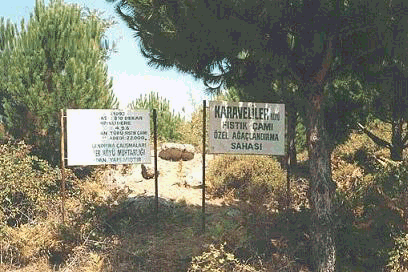
Figure 1.4. Private afforestation areas in the village of Karaveliler.
Harvesting permits for Stone Pines in state forests are given to the village legal entities with symbolic tariff prices (25,000 Turkish liras/kg in 2002). Village legal entities advertise the areas in state forests and areas belonging to village legal entities to villagers by parcel name and location. Advertisements are posted for 15 days, and during this time individuals evaluate the lands with the help of experts and decide which lands they want.
Tenders are carried out in December or January. The tender value (cost) is received by cash or “küner” (nuts with bark) and paid in three installments: one-third (1/3) within 15 days, with the remainder paid on July 20 and October 20.
As we have seen, the lands in state forests and private afforestation areas are allocated on behalf of village legal entities and managed by them. The controls of the Forest Department have greatly eased the village legal entities’ procedures. In addition, village legal entities have been solving disputes among individuals. Afforestation areas are very close to state forests and serve as a buffer between private and state forests (Figure 1.5). Therefore, the village legal entities’ management of these areas has also been preferred by the Forest Department.
Village legal entities are quite effective executive mechanisms in the villages and the Turkish village system. Villages are local authorities that have public legal entities. The roots of this structure go back to the early years of the Republic. Villages were established by Village Law No. 442 dated 18 March 1924, which defined villages as settlements having 150-1,999 residents. As local administrations, they have the duty to provide services and activities in order to meet the local and common needs of their inhabitants. In the light of villagers’ demands, they pursue their duties to promote socioeconomic improvement and development.
![]()
![]()
![]()
![]()
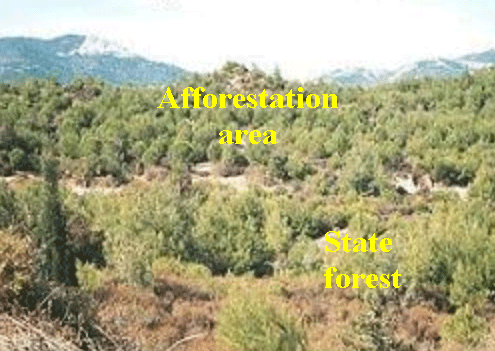
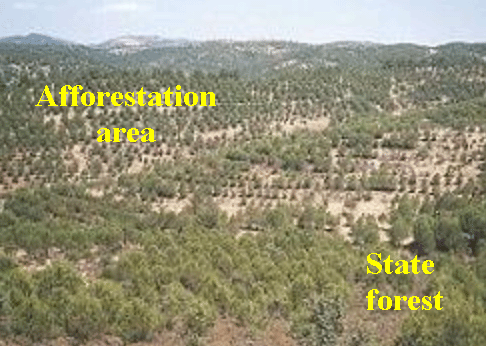
Figure 1.5. Afforestation areas constituting a buffer zone between private and state forests.
As the result of Kozak’s rising welfare level, new investments have begun to be discussed. After the failure of entrepreneurial efforts by individuals and village legal entities, a federation for the “Protection and Improvement of the Kozak-Madra Creek of the Town of Bergama in the İzmir Province for Ensuring Services to Local Villagers” was established by Cabinet Law No. 2002/5116 dated 27 Dec. 2002 with the assent of the Kozak villagers and the leadership of the town mayor in the region. The federation’s headquarters is in Yukarıbey. The local governor and muhtars (village leaders) of the founding villages are permanent federation members. The private management director of the town is an observer. The tasks of this federation can be summarized as follows:
a) To promote the development and improvement of villages in the areas of education, health, social unity, youth and sports, culture and tourism, agriculture, and economy and trade.
b) To encourage the development of cooperatives.
c) To provide service and leadership on the environment, forests, and afforestation.
d) To identify and promote suitable areas for tourism.
e) To solve village problems in such areas as transportation, infrastructure, sewage systems and drinking water.
f) To ensure the common management and utilization of such resource utilities as geothermal water resources, spring waters and thermal facilities, if present in the region.
After the federation was established, it began studying the needs of the Kozak region.
Villagers in the Kozak region wait for the product to become ripe and do the harvesting in the appropriate period. As the economic value of the nut has risen, more attention has been paid to the harvesting season. In regions outside Kozak, pine nuts are usually harvested prematurely. There, the lands are state forests. Villagers harvest more products, and since the lands lack individual owners, there has been a recurring illegal harvesting problem. Therefore, the General Directorate of Forestry has recently been making arrangements for the harvest time of nuts in state forests. Permission is not given to collect cones before November 10. This system has been running well for 3-4 years.
Pine nuts harvested in other regions are usually sold in Kozak. However, Kozak villagers do not mix these with their own products, due to the outside nuts’ low quality, and take care to utilize these nuts separately.
The collection time for cones from the Stone Pine trees is long; harvesting starts in December and lasts until May. The cones open and cause product losses when temperatures rise after mid-April. Harvesting is suspended during cold weather, due to the greater risk to the harvesters’ safety of breaking branches. Long poles called “keye” are made from the platanus tree and fitted with a special device on top for use in harvesting the cones. Harvesting is a profession. Harvesters climb the trees with the help of keyes and get the cones down by striking them (Figure 1.6).
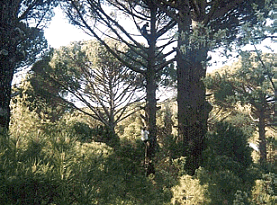
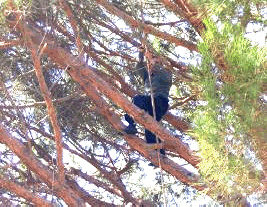
Figure 1.6. Men harvesting Stone Pine cones.
Care is taken to take down only 3-year-old mature cones. The fallen cones are then collected by women and carried to drying areas (Figure 1.7).
The cones dry under sunlight and open by themselves. The women then extract the barked nut seeds from the cones and put them in special cases, whereupon they are stored in private or cooperative depots till they are marketed.
Mechanization has been developed to process the nuts (Figure 1.8), because initially, nuts were being broken and extracted by hand, one-by-one, in houses. In the early years of harvesting, traditional methods led to 5-10% of the product suffering damage. But in the years since, the use of machinery bought from Italy and Spain with the help of the Yukarıbey Nut Cooperative has cut the incidence of damage to as little as 1-2%.
Beyond the nut cooperative, there are also some private processing establishments in the region, but these are very small-scale enterprises. Some producers prefer to sell their products to these individuals since they pay in cash at the time of the transaction and pay a higher price as they avoid a special tax.
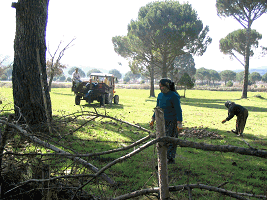
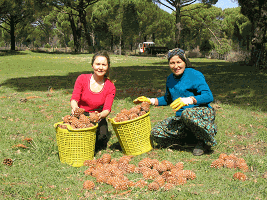
Figure 1.7. Women collecting Stone Pine cones.
The Kozak region generally sees little selling of land. According to a local saying, the only way to obtain land is to marry a girl from Kozak. When locals have money problems, village legal entities often step up to offer good prices for their land rather than risk its sale to outsiders.
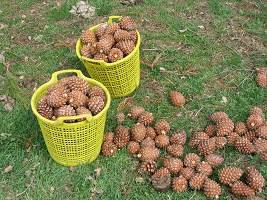
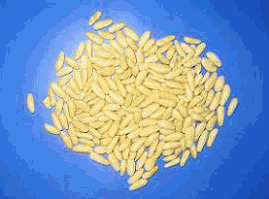
Figure 1.8. Cones, and nuts without bark.
The sale of lands of village legal entities to individuals is a complex procedure. In brief, village councils must give their approval. But villagers normally elect not to do so, since not all villagers will reap benefits from revenues earned from these lands.